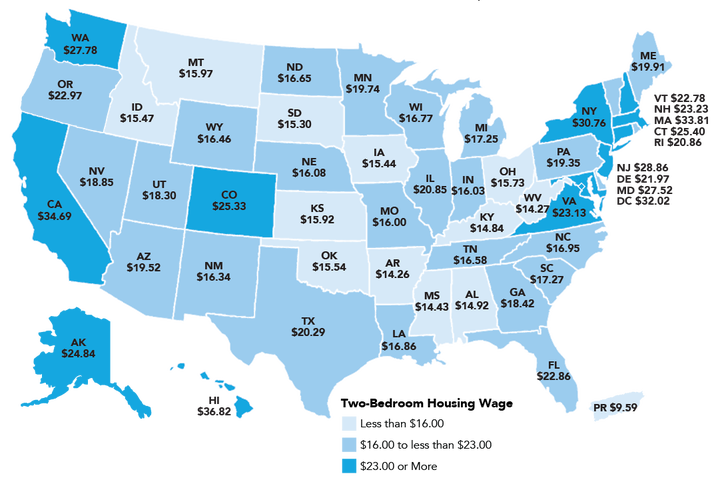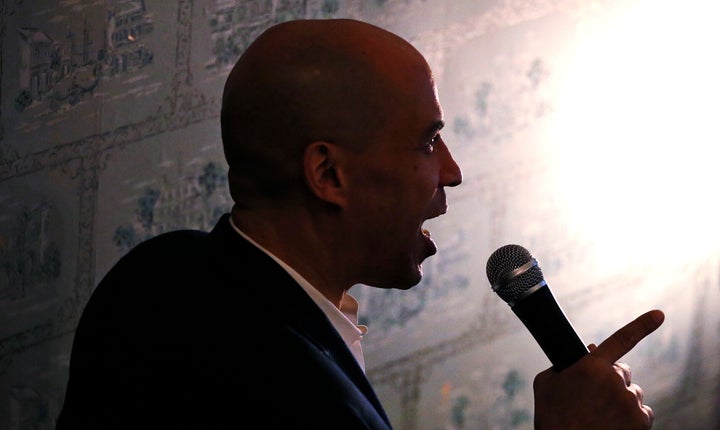The ‘Out of Reach’ report shows the housing crisis is hitting renters hard, especially those earning the minimum wage.
On June 18, 2019, Laura Paddison writes on Huffington Post:
Plenty of evidence shows how widespread and devastating America’s housing crisis is, but perhaps none quite as starkly as this: There’s not a single state, metropolitan area or county in the U.S. where a full-time worker earning the minimum wage can afford the rent for a modest two-bedroom apartment.
Affordable housing is fundamental to a safe, healthy, stable life. It brings a host of advantages, including better physical and mental health outcomes, better access to education for children, and a better chance at upward economic mobility. Yet, for a huge swath of the population, it remains completely out of reach.
A worker earning the federal minimum wage of $7.25 an hour would need to work nearly 127 hours a week – equivalent to more than three full-time jobs – to afford a modest two-bedroom rental without spending more than 30% of their salary on housing costs. To afford a modest one-bed rental, they would need to work 103 hours a week.
These figures come from the National Low Income Housing Coalition’s annual Out of Reach report, published on Tuesday, which for 30 years has documented the gap between renters’ earnings and rental costs across the country.
The report takes the “fair market rent” of modest one- and two-bedroom rentals (defined as the Department for Housing and Urban Development’s best estimate of what a family moving today can expect to pay) and then calculates the hourly wage a renter would need for it to be affordable (meaning he or she spends no more than 30% of their income on housing costs).

A full-time worker needs to earn $22.96 an hour, on average, for a two-bedroom rental to be affordable, according to the report. That’s $15.71 an hour more than the federal minimum wage, and $5.39 more than the national average renter’s wage of $17.57.
For a one-bed rental, a full-time worker needs to earn $18.65 an hour, an amount above both the federal minimum wage and the average renter’s wage.
“The housing crisis is very bad,” said Diane Yentel, president and CEO of the National Low Income Housing Coalition. “It’s worse that it’s been in a long time and it continues to get worse.”
While rent in every state is unaffordable to minimum-wage workers, there are huge differences in the unaffordability. The most expensive state is Hawaii, where the fair market rent on a modest two-bedroom is $1,914 a month. To afford that, a worker in the state must make $36.82 an hour – equivalent to working 3.6 full-time minimum-wage jobs.
Arkansas, where the fair market rent for a two-bedroom is $742 – is the most affordable state. Full-time workers there need to make $14.26 an hour to afford a two-bedroom rental, significantly above the state’s minimum wage of $9.25.
Drilling down to the metro area level, the report’s figures are even starker. The most expensive is San Francisco, where full-time workers need to make a staggering $60.96 an hour to afford a two-bedroom rental. The city’s minimum wage is $15.

Disparities also exist along racial lines.
“The housing crisis most negatively impacts low income people of color,” said Yentel, “and that’s because they are more likely to be renters, they are more likely to be extremely low-income renters and they’re more likely to be extremely cost burdened as renters.”
Decades of discriminatory housing policy are to blame, Yentel said, as well as job discrimination locking people of color out of many decent-paying jobs. The median black worker and the median Hispanic worker both earn 27% less than the median white worker, according to the report.
There’s no sign that affordability is going to improve anytime soon – mainly because of the jobs the economy is creating.
The median wage for eight of America’s 10 largest occupations – from retail salespeople to fast-food workers to home health aides – is not enough to cover a one-bedroom rental. And these are the jobs that are likely to see the biggest growth over the next decade, further entrenching the disparity between wages and housing costs.

Nearly 40% of all U.S. renters now pay more than 30% of their incomes on housing costs, and the number of renters paying more than half of their income toward housing costs increased by 3.6 million from 2001 to 2016. Many Americans are just one unexpected expense away from potential disaster: Around 40% said they would not be able to cover a $400 emergency.
The human cost is clear. Research shows that affordable housing improves pretty much all life outcomes. “So the flip of that is also true,” said Yentel, “when people are housing insecure or homeless, their health suffers, kids are not able to do well in school, they often have to change schools, they are not able to earn as much over their lifetimes.”
The National Low Income Housing Coalition has called for bold government action on housing, including a huge injection of federal funds to increase affordable housing.
But hope of this happening under President Donald Trump seems exceedingly slim. His administration has called for sweeping cuts to affordable housing programs and has proposed rule changes which, Yentel said, “would actually increase homelessness in our country and it would increase it for some of our country’s most vulnerable people.”
The administration wants to prevent undocumented immigrants accessing federally subsidized housing, which could potentially leave up 55,000 children, who are U.S. residents or citizens, at risk of eviction and homelessness. And last month, Housing and Urban Development Secretary Ben Carson proposed a rule change that would take away protections for transgender people at homeless shelters, potentially making it much harder for them to access facilities.
Despite all this – maybe because of it – Yentel is hopeful. “I do feel like we are reaching a tipping point and that public opinion and public pressure for solutions are growing and that policymakers increasingly are heeding that call.”
Some Democratic presidential hopefuls have set bold housing policies. Sen. Cory Booker (D.-N.J.), this month launched a big housing proposal, which included the introduction of a tax credit to cap the amount of rent Americans pay at 30% of their salary.

A similar tax credit has been proposed by Sen. Kamala Harris (D-Calif.). Sen. Elizabeth Warren (D-Mass.) has plans to drastically increase the number of affordable homes by putting around $500 billion over a decade toward helping states build and maintain housing for extremely low-income renters.
States and cities are also acting. Oregon became the first to introduce statewide rent control in February, with a bill to cap rent increases at 7% annually plus inflation, and to prevent landlords from evicting tenants within the first year without sufficient reason.
In December, Minneapolis changed zoning rules to make it possible to build multi-family units on land that was previously reserved for single-family homes. Corianne Scally, principal research associate at the Urban Institute, said this is not only innovative, but also a challenge to other cities “to think about what the true benefits and costs are of separating land use so much that neighborhoods become disconnected and people don’t have more housing choices.”
And last week, New York state announced a package of changes to strengthen protection for renters that will be voted on this week. These include ending big rent hikes for people in rent-regulated apartments, better protection for tenants around eviction, and making unlawful eviction a crime.
Yentel hopes Tuesday’s report will serve as a further reminder of the severity of the crisis, and the urgency for policymakers to act.
“So long as there is a national housing shortage,” Rep. Ayanna Pressley (D-Mass.) writes in the foreword to the report, “the American Dream remains largely deferred.”

